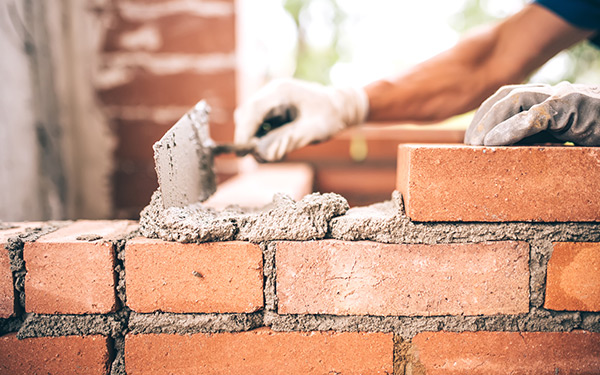Unlocking the Tricks of Sustainable Masonry Building Practices for Eco-Friendly Buildings
Among the myriad strategies to environmentally friendly building, sustainable stonework construction stands out as a tried and true and long lasting approach that holds a wealth of untapped capacity. From the selection of products to cutting-edge construction methods, the keys to attaining sustainability within masonry building are diverse and interesting.
Benefits of Lasting Stonework Construction
Accepting lasting stonework building and construction techniques not only minimizes ecological effect but likewise supplies lasting economic advantages to building contractors and communities. By making use of materials like recycled bricks, obstructs, and rocks, home builders can considerably decrease the carbon impact of their jobs while promoting source effectiveness. Additionally, lasting stonework building techniques, such as correct insulation and thermal mass homes, can enhance power effectiveness within buildings, causing decreased functional expenses gradually.
Furthermore, the sturdiness and strength of stonework frameworks add to long-lasting financial advantages. Structures created using lasting masonry practices usually need much less upkeep and repair service, translating to cost savings for home builders and homeowner. The long life of stonework materials likewise makes sure that frameworks remain secure and secure, lowering the demand for regular restorations or substitutes.
Eco-Friendly Stonework Materials
Making use of eco-friendly stonework products is a crucial action towards boosting the sustainability of building techniques and lessening ecological effect while maximizing lasting financial advantages. Lasting masonry products are sourced, created, and utilized in a fashion that minimizes general environmental impact. Sustainable concrete blocks integrate recycled accumulations and may feature enhanced insulation properties, contributing to energy efficiency in buildings.
Additionally, all-natural materials like adobe, rammed planet, and straw bales provide superb thermal mass properties, lowering the requirement for heating and cooling down energy. These materials are frequently locally available, promoting regional economic situations and lowering transportation-related carbon discharges. By picking environment-friendly masonry products, building projects can dramatically lower their environmental impact and contribute to the development of healthier, extra lasting constructed atmospheres.
Energy-Efficient Stonework Techniques
Power performance plays an important role in improving the sustainability of stonework building techniques. By executing energy-efficient stonework strategies, home builders can substantially lower the overall energy usage of a structure, bring about lower functional prices and a smaller sized environmental footprint. One vital energy-efficient stonework strategy is using thermal mass, which includes integrating thick products like concrete or block into the building's structure to take in and save warm. This assists manage interior temperatures, reducing the requirement for mechanical heating and cooling systems.

Technologies in Sustainable Stonework
Recent developments in lasting masonry methods have actually brought around innovative methods that are reshaping the building industry. One such innovation is the advancement of self-healing concrete, which makes use of bacteria installed within the concrete to heal splits autonomously. This breakthrough not just minimizes maintenance prices but also boosts the sturdiness of stonework frameworks, adding to their sustainability.
An additional notable development is making use of recycled aggregates in stonework construction - masonry contractor. By integrating products such as crushed ceramic waste or recycled glass into concrete blends, builders can reduce the environmental influence of construction tasks while maintaining structural stability. This technique not only draws away waste from garbage dumps but also saves natural sources, making it a vital advancement in sustainable masonry building
Moreover, the assimilation of electronic design tools, such as Building Info Modeling (BIM), is reinventing the means masonry frameworks are prepared and built. BIM enables even more exact estimations, lowered material waste, and improved power performance, eventually resulting in more lasting structure techniques. These developments collectively indicate a promising future for sustainable stonework construction in the era of environmentally friendly structures.
Future Trends in Stonework Sustainability
With the cutting-edge strides made in lasting stonework practices, the future patterns in masonry sustainability are positioned to additional revolutionize the building industry. One of the vital fads shaping the future of masonry sustainability is the increased integration of technology. Improvements such as Structure Details Modeling (BIM) and online reality simulations are being used to maximize masonry construction procedures, bring about decreased material waste and improved power efficiency in buildings.
In addition, the advancement of unique lasting materials is readied to play a significant duty this content in improving the click now eco-friendliness of stonework building and construction. masonry contractor. Innovations like self-healing concrete, recycled accumulations, and bio-based binders are acquiring grip for their capacity to minimize ecological effect while maintaining architectural integrity

Conclusion
In final thought, lasting masonry concrete accessories building techniques offer various advantages for environmentally friendly structures. By making use of environment-friendly products and energy-efficient techniques, stonework can contribute to an extra lasting constructed environment. Advancements in lasting masonry are continuously being established to additionally enhance the environmental performance of structures. Looking in the direction of the future, the fad of stonework sustainability is expected to grow, causing even more ecologically friendly and energy-efficient building techniques in the years to come.